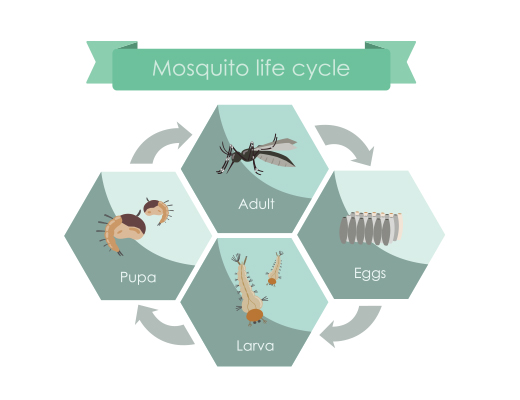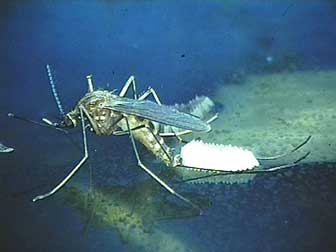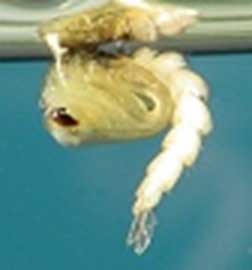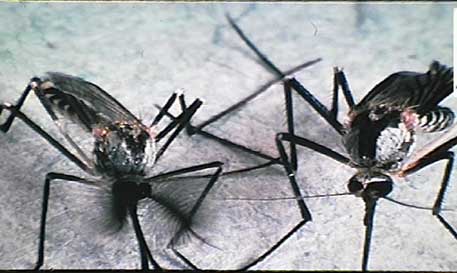The mosquito goes through four separate and distinct stages of its life cycle: egg, larva, pupa, and adult.

Eggs:
- Laid in standing water, moist soil, sides of containers.
- Laid singly by some species and others lay eggs together to form rafts.
- Float on the water’s surface until they hatch.
- Incubation period may vary considerably among different species.
- Eggs of permanent-water breeders are deposited on the water surface and may hatch in 1-3 days, depending on temperature
- Floodwater species deposit their eggs on moist soil or another wet substrate and display a wide variation in incubation periods, from several days to a year or more depending on the species and the season

Larvae: (also known as wigglers or wrigglers)
- Live in water and have four developmental periods or instars.
- At the end of each instar, the larva sheds its skin by a process called molting.
- Have three body parts, head thorax and abdomen.
- The head bears the antennae, eyes, mouthparts, and hairs of various sizes.
- The mouthparts include a series of brushes, which vibrate to rapidly sweep in small organisms on which the larvae feed.
- The thorax is broader than the head or abdomen and has several groups of hairs that are useful for the identification of the species. Neither wings nor legs are present in the larval stage.

Pupa:
- Very active, and, like the larvae, lives in the water.
- Differs greatly from the larvae in shape and appearance.
- Comma-shaped body divisible into two distinct regions.
- The front region consists of the head and thorax and bears a pair of respiratory trumpets on the upper surface.
- The second region is the abdomen, which has freely movable segments with a pair of paddle-like appendages at the tip.
- The pupal stage lasts only for a few days.
- Feeding does not occur during this stage.
- Once the metamorphosis is complete, a pupa will go to the surface of the water.
- Casing will split and an adult mosquito will emerge.

Adult:
- After breaking free of the pupal skin, the adult will rest on the water"s surface for a brief period of time to allow its body and wings to dry and harden.
- Entirely terrestrial, capable of flight, and feeds largely on nectar.
- Three distinct body regions: head, thorax, and abdomen.
- The head bears a pair of large compound eyes, a pair of antennae, a pair of palpi, and a large proboscis (used for blood meals).
- The thorax is composed of three segments.
- Pair of long, slender legs arises from the lower side of each of the segments
- A pair of transparent wings is attached to the second segment
- A pair of small knobbed structures, known as halteres, is found on the third segment. These halteres vibrate rapidly when the mosquito is in flight, serving as organs for balance
- The abdomen is composed of 10 segments.
- First 8 segments are similar and unmodified
- Ninth and tenth segments are greatly modified for reproduction in both sexes
- All parts of the body are covered to some degree with coarse hairs or scales which contribute to various color patterns that are useful in identifying the species.
- The male mosquitoes have feathery antennae.

Mosquito Facts
- Only female mosquitoes seek blood meals.
- The proboscis is the structure that is inserted by the female mosquito into the host's skin to obtain a blood meal.
- In males, the proboscis is not suited for piercing skin and is used to only suck nectar and plant secretions where no piercing is required.
- The tip of the abdomen in the females is either tapered or blunt, which aids in the identification of different genera of mosquitoes.
- The color pattern of the abdomen may vary from one species to another.
- Different species will have different characteristics and behaviors.
- active time period (e.g., daytime or nighttime feeder)
- how far they fly from their hatching source
- types of animals they "prefer" to bite (Example: some prefer birds over mammals)